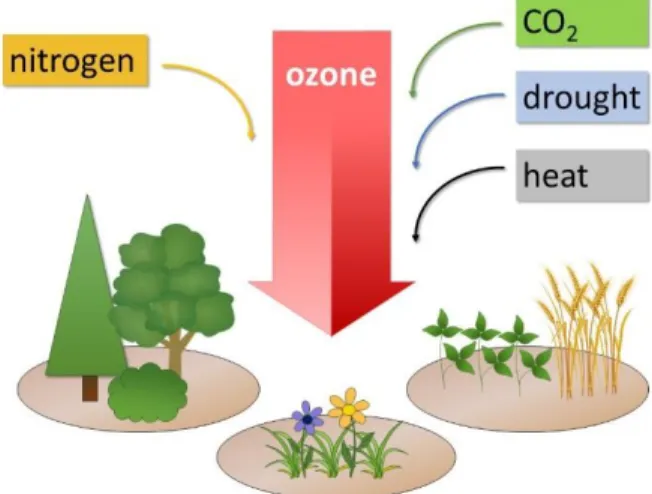Effects of ozone on vegetation are modified by nitrogen and factors of climate change
Elke Bergmann1, Jürgen Bender1
• Tropospheric ozone has been identified as the most damaging air pollutant to vegetation.
• The impacts of ozone in a future nitrogen polluted and changing climate depend on the ozone sensitivity of plant species and the respective concentration and intensity by which the climate change factors interact with ozone.
• While both elevated CO
2and nitrogen input offered some protection from ozone damage, drought stress can exacerbate the negative effects of ozone.
Background and aims
Tropospheric ozone (O
3) is considered the most significant phytotoxic air pollutant negatively affecting plant growth, development and productivity. In the context of the Convention on Long-Range Transboundary Air Pollution (CLRTAP) critical levels for O
3to protect vegetation have been derived for different types of vegetation and they are continuously developed on the basis of present scientific knowledge.
Critical levels are used to estimate the O
3risk for vegetation in the current and future pollution situation in Europe as a basis for mitigation measures in the European air pollution control policy. The derivation of O
3critical levels is based on many years of research on the impact of O
3on vegetation by means of experiments in which plants were exposed to different levels of O
3, mostly under otherwise optimal growth conditions.
However, it is known that the effects of O
3in the field can be significantly modified by a number of other environmental and anthropogenic factors.
The objective of the project was to review the available literature and to summarize the current knowledge on how factors of climate change, including temperature and drought stress, nitrogen input and increased CO
2concentrations influence or alter the responses of plants to O
3(Figure 1). The study therefore aims to contribute to a more realistic estimation of ozone risks for vegetation in a future climate.
Approach
A systematic literature search was performed using Web of Science
TM(Core Collection, Biological Abstracts, CAB Abstracts) encompassing reviewed papers, book chapters, or research reports starting with the year 1990 and describing results of factorial experiments in which plants have been subjected to exposures of different levels of O
3in combination with treatments where N, CO
2, temperature, or soil moisture was manipulated. Focusing on crops, forest trees and grassland
species, the available literature was analyzed with respect to assess the current knowledge about how temperature and drought stress, N input, and elevated CO
2concentration can modify growth, yield and gas exchange responses to O
3.
Figure 1: Ozone impacts on vegetation in a future nitrogen polluted and changing climate
Source: Thünen Institute/Elke Bergmann
Results
A total of 315 literature references were evaluated which described interactive effects of O
3with either elevated CO
2, drought stress, temperature, or N input for 65 species. The study shows that, to varying degrees, these other factors may exacerbate or ameliorate the effects of O
3. In principle, elevated CO
2and N as "fertilizers" have positive effects on plant growth.
Although our analysis revealed a great variability in responses to combined exposures with O
3, both factors reduce adverse O
3effects or even cause a net positive effect in the majority of the
Thünen Institute of Biodiversity 2021/13a
Further Information
Contact
1 Thünen Institute of Biodiversity juergen.bender@thuenen.de www.thuenen.de/bd
Duration 2.2020-10.2020 Project-ID 2363
Publication
Bergmann, E, Bender, J (2021). Effects of ground-level ozone on vegetation modified by nitrogen and components of climate change: a literature study.
Umweltbundesamt Texte 29/2021, 155 p.
Support
DOI:10.3220/PB1618491100000
experiments (Figure 2). However, the extent of this net effect appears to depend on the concentration of O
3, the O
3sensitivity of the plant species, the concentration of CO
2or the amount of N, respectively, and the response parameter considered. This means, for example, that high O
3exposure levels may also significantly limit the positive growth effects of CO
2and N.
The lower magnitude of negative O
3effects at elevated CO
2were often associated with a lower flux of O
3into the leaf due to lower stomatal conductance at elevated CO
2. Similarly, drought stress may limit O
3flux into the leaf as stomata close to prevent water loss. However, when plants are simultaneously exposed to O
3and soil moisture deficit we found that in some studies drought reduced symptoms of O
3-induced leaf injury (mainly in grassland species), but drought stress tended to exacerbate O
3effects on growth and biomass in crops and young trees (Figure 2), suggesting that drought stress dominated over the O
3stress in these studies.
There have been very few experiments that manipulated both O
3and elevated temperature. A general conclusion on the combined effect is difficult to derive, although critical growth stages such as anthesis are sensitive to both stresses.
Figure 2: Box-Plots of the effect of ozone alone and in combination with elevated CO
2, additional nitrogen and drought stress on plant biomass, calculated as percentage change from an O
3unpolluted control. The underlying data come from experiments with crops, trees and grassland species.
Source: Thünen Institute/Elke Bergmann

